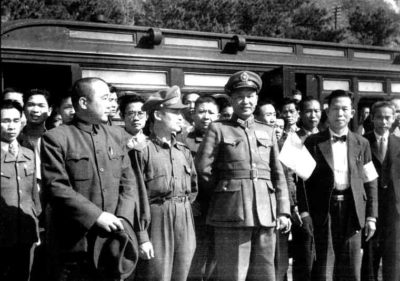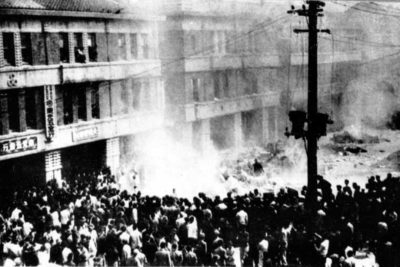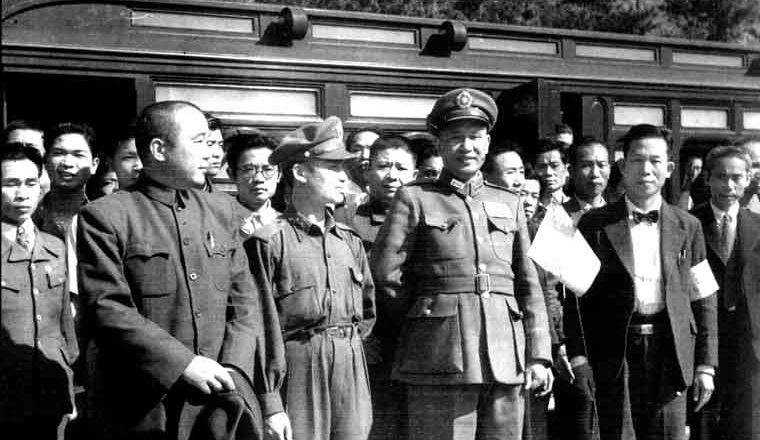A nation must think before it acts.

After the oppression by the Chinese Nationalist Army in the 228 Incident, Chung-xi Bai, then the Minister of Defense of Chinese Nationalist Government, went to Taiwan for a visit.
Though a vibrant and thriving democracy today, the Republic of China (Taiwan) was once a nation plagued with corruption, mass violence, and totalitarian rule. In Taiwan, the period immediately following the 228 Incident is known as the “White Terror” for the massive suppression, murder, and imprisonment of political dissidents, or anyone who the Kuomintang (KMT), known as Nationalists in English, perceived as a threat to its one-party rule. The Martial Law that was implemented in the aftermath of the incident was not lifted until 1987.
The story of the 228 Incident—named after the day on which the terror began, February 28—can be traced back to 1945 and the rampant dissatisfaction that local Taiwanese had for the governing officials of the Republic of China after the end of World War II. The Kuomintang controlled the island while the party engaged in a war against the communists and Mao Zedong.
The immediate story begins the day before, on February 27, when agents from the Tobacco Monopoly Bureau confiscated a cigarette vendor’s illegal cigarettes as well as her money, and then beat her over the head with a pistol while attempting to arrest her. A large crowd swarmed the agents, prompting one to open fire on the crowd, killing one person. The incident led to mass protests the next day—February 28.

Taipei Branch of the Bureau of Monopoly, was occupied by angry crowd.
A crowd of 2,000 gathered to march on the Tobacco Monopoly Bureau to demand that the agent in question be executed and that the director of the bureau resign. While that march occurred, another group discovered two Tobacco agents and beat them to death. A large crowd then gathered outside of the Governor-General’s office, where they were fired upon without warning, and several protestors died. As a result, protests erupted all across Taiwan, targeting government offices and Mainlanders.[1] Local Taiwanese took control of most of the cities and towns.
Unrest lasted from the 28th of February to March 7 when the Kuomintang violently cracked down on the locals. On March 1, a committee was formed to investigate the cigarette vendor affair, but while the committee was investigating, the military was patrolling Taipei firing at random and killing indiscriminately. On March 7, the Committee to Settle the Monopoly Bureau Incident (Settlement Committee), comprised of students, legislators, and other professionals who represented the people in investigating the 228 Incident and proposing governmental reforms, submitted 32 Demands to Governor-General Chen Yi addressing issues of democratizing Taiwan: having local Taiwanese in government office; providing basic freedoms like freedom of speech, press, organization; and guaranteeing the rights of aboriginals. Many of the demands read similarly to the issues that America’s Founding Fathers addressed to King George III in the Declaration of Independence. Both were documents advocating giving power to local residents.
The next day, reinforcements arrived from the Mainland, which marked the beginning in earnest of the crackdown in Taiwan. One report estimates that the Nationalist army killed thousands of people by the end of the month. Soldiers fired upon innocent, unarmed civilians in an attempt to instill fear in the people and thereby restore order. Soldiers summarily executed groups of people, raped women, and even beheaded people. Students who helped to maintain order in the streets during the rioting were tricked into turning themselves in and were subsequently imprisoned or executed. The entire island of Taiwan was terrorized by the military and government. People, especially dissidents, began to disappear and were never heard from again.
228 & Taiwan Today
Due to a massive cover-up and the destruction of government documents, no one knows exactly how many people died. Some estimates are as high as 28,000 or as low as 18,000. Taiwan lost some of its best and most influential citizens during this period. The current mayor of Taipei, Ko Wen-je, participated in a bike ride from Taiwan’s northernmost point to its southernmost (520 kilometers) in 2016 in honor of his grandfather, who died from injuries sustained while being tortured by the KMT. During the bike trip, he said, “Taiwanese have to be the owners of Taiwan. Taiwanese have to decide their own fate and Taiwanese have to build a new world of fairness and justice. That is my goal and belief. I would like to encourage us all with the idea of a ‘Taiwan achieved with a sea of tolerance,’ so we can learn from history and leave the sadness behind.” The 228 Incident was—and still is—an important moment for Taiwanese identity.
The scars from the White Terror are still felt throughout Taiwan today. Martial Law did not end in Taiwan until 1987; the first free and fair legislative elections took place in 1992; and the first fully democratic presidential election was held in 1996. Now, for the first time in the country’s history, the Democratic Progressive Party, not the KMT, controls both the executive and legislative branches of government—something that protesters never would have imagined possible during the White Terror. People outside of Taiwan often forget how recently the country democratized—accomplishing its peaceful transformation to a political system consistent with international democratic norms without being a member of the United Nations or having official diplomatic relations with a majority of the world’s countries. Such progress and feats are impressive, especially under the shadow of the White Terror.
Taiwan has admirably worked towards addressing the horrors of the White Terror. In 1995, President Lee Tung-hui officially apologized for the government’s actions and advocated for open discourse about Taiwan’s troubled past. Just blocks away from the Presidential Palace in Taipei is a museum and park memorializing the victims of the 228 Massacre. The museum is on the site of a radio station that activists stormed on February 28 to inform the rest of the country of what occurred. The park houses a sculpture honoring the victims, and part of its inscription says,
The task of healing a serious trauma in a society must depend on the whole-hearted collaborative effort by all its people. We have, therefore, inscribed these words on this memorial plaque in the hope of consoling the spirits of the victims and comforting their grieving families. It is also hoped that these words will serve as a warning and a lesson to all Taiwanese compatriots. Henceforward, we must be one, no matter which communal group we belong; we must help each other with compassion and treat each other with sincerity; we must dissolve hatred and resentment, and bring about long lasting peace. May Heaven bless Taiwan and keep it evergreen.
February 28 is now a national holiday meant for everyone to remember, honor, and acknowledge the spontaneous protest movement that occurred as a result of one woman standing up against an authoritarian government’s arbitrary and oppressive ways.

Chiang Kai-Shek Memorial Hall (Source: edwin.11/Flickr)
This year marks the 70th anniversary of the 228 Incident, so special attention is being given to the event, including the role of the KMT and Chiang Kai-shek, the Chairman of the KMT and President of the Republic of China until his death in 1975. The 228 Memorial Foundation continues to work toward providing victims’ families with proper compensation and preserving documents related to the White Terror. Recently, funds seized from the KMT have been given to victims’ families. The chairman of the foundation is calling for the government to accept the fact that Chiang was responsible for ordering the executions of civilians in 1947 and beyond. “All the evidence points to Chiang being responsible for the Incident, so he should have to pay a price.” One university in Taiwan, National Chengchi University—my alma mater—recently passed a measure calling for the removal of all statues of Chiang Kai-shek due to his harsh rule and role in the 228 Incident and White Terror. There are also calls to remove statues of him all across Taiwan as a part of the 70th anniversary, even from the Chiang Kai-shek Memorial Hall. Official stores are now prohibited from selling Chiang merchandise, and the hall no longer plays “The Chiang Kai-shek Memorial Song” at opening and closing hours. Having a country and government discuss the sordid parts of a founding leader’s behavior/story/role is something can only happen in a free, democratic society, which Taiwan has clearly become.
Taiwan Moving Forward
Recent events notwithstanding, Taiwan still has room for growth in addressing its past. President Tsai Ing-wen has promised to declassify more documents relating to the government’s role in the incident. The government has done so much to accept responsibility; it should not quell[??] at the thought of explicitly implicating Chiang. According to Ko, the current mayor of Taipei, Taiwan has not done enough to name “who the perpetrators were,” blaming “Taiwanese forgiving nature” for not holding them responsible. Perhaps the 70th anniversary is an appropriate occasion to do so.
Even former President Ma Ying-jeou, a member of the offending KMT, acknowledged the importance of 228. In 2013, he did not shy away from addressing it: “I am here to promise again that the government will defend democracy and freedom in Taiwan. It is crucial to consolidate the core values of democracy and institutionalize the protection of human rights so that tragedies like the 228 Incident will not happen again.” Countries around the world—the United States included—can take a page out of Taiwan’s book when it comes to acknowledging ugly events in their own histories.
This year, the People’s Republic of China announced that it would commemorate the 70th anniversary of the 288 Incident. The Communist Party of China has addressed the incident’s role as a part of Chinese history, but limited its scope to the history of the Kuomintang’s regime on Taiwan. Yet, China blocks its own citizens from learning about the Tiananmen Square Massacre of 1989. That is quite the hypocrisy—playing up the opposition’s massacre and refusing to acknowledge your own and other human rights abuses. It has yet to address the role of Tiananmen in its own history.
Though Taiwan’s presidents and other politicians have openly acknowledged and apologized for the 228 Incident, the White Terror, and other black marks of authoritarian rule, the government has yet to take the final necessary step to turn the page of history. There has not yet been a formal truth and reconciliation commission to fully acknowledge the atrocities, victims, and perpetrators—for all wounds to fully heal, there must be one before those who took part in the White Terror and other atrocities of the martial law era pass away. In her inaugural address, Tsai announced plans to create such a commission in three years to “to address the historical past in the most sincere and cautious manner. The goal of transitional justice is to pursue true social reconciliation, so that all Taiwanese can take to heart the mistakes of that era.” Tsai can release every document remaining, and every statue of Chiang can be removed, but Taiwan—as vibrant and free as it is—can never fully move forward without a full, public airing of atrocities.
For those living outside of Taiwan, we should focus on the incredible turn that Taiwan has made toward both democracy and apology. This lesson demonstrates that a people or government can accept its dark past, while still moving forward for the benefit of all citizens. Though often forced to the margins in the international community, the world has much to learn from Taiwan, its trajectory from authoritarianism toward democracy, and its acceptance of history.
[1] The term “Mainlanders” during this period refers to people, primarily members of the Kuomintang, who came to Taiwan from the Chinese Mainland during or after the end of World War II. They differ from “Taiwanese” who at the time were indigenous to the island. Nowadays, “Taiwanese” refers to all people of Taiwan, indigenous and Kuomintang alike, while “Mainlander” refers to people living in the People’s Republic of China.




